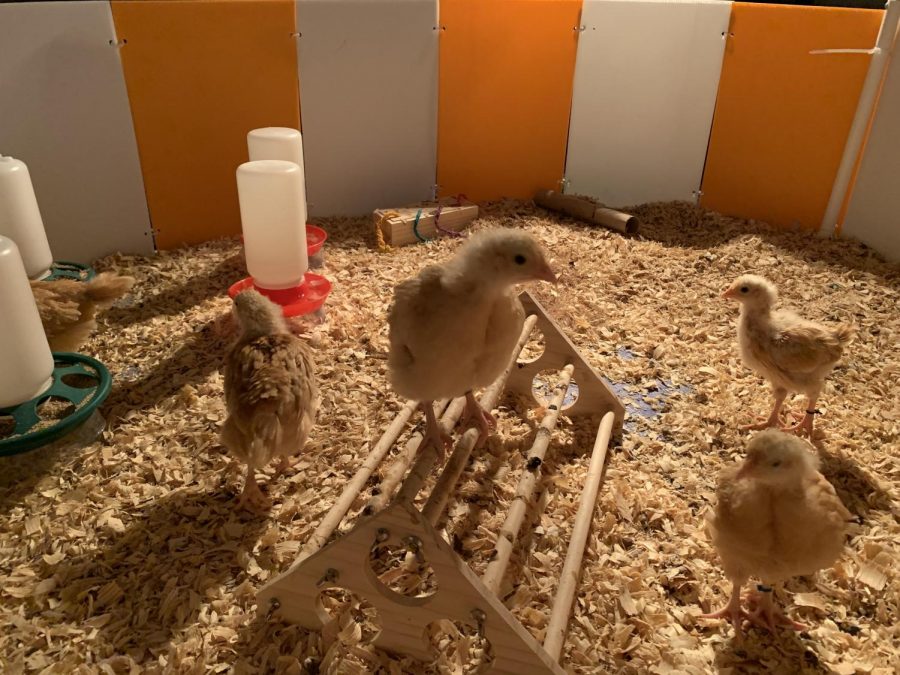STEM students take on scientific discovery
Shayna’s chickens play in their classroom pen
This year, a new STEM class has been implemented into the curriculum. The STEM Capstone class allows students to initiate their own research for a question they have created.
STEM Capstone is a one semester class that can be taken several times and is available to all grade levels. Students present their findings to the class after concluding their research.
“The purpose is to give Vernon Hills High School students the opportunity to do independent research, and to really delve into areas of interest, and to perform true scientific investigations about those areas of interest,” Amy Elliott, the instructor of the class, said.
Shayna Weinstein (12) is testing how human interaction affects the cognitive development of chickens.
Weinstein started by writing a proposal to Mark Prosise, the head of the science department. In the proposal, Weinstein outlined the question being researched, materials required, variables, and a timeline. Once it was approved, the supplies were ordered.
Shayna Weinstein is currently in the process of research. She pets, holds and talks to the chickens. Every one receives positive attention, but some will receive it one, three, or five times a week.
“The week that I’m not doing [interactions], I’m testing…I’ve been taking the chicken out into the class… I sit there and see how it responds, and if there are any stress calls, like chirping really loud,” Weinstein said.
To measure the cognitive development of the chicken, Weinstein records how easy it is to teach each chicken tricks and how long it takes each chicken to learn how to target train, a process where an animal learns to touch an object, usually with their paw or nose, after being given a command.
Benjamin Dudek (9) is in the proposal phase and is working to come up with a concise question to title his project. However, he knows that his project will include working with biofuel.
Biofuel is energy made from plants or plant-based material, and Dudek will be researching how the yield of this can be increased through a specific separation process.
“Cellulose is a powder that’s made from biomass. It’s created. And then you have cellulase, the enzyme that is supposed to break down the sugars in cellulose…when cellulose [is] combined with the buffer and the reaction occurs, you have ethanol and alcohol. And scientists are constantly trying to get a better separation technique to separate those two,” Dudek said.
Dylan Lussem (11) is also in the beginning stages of their project, as they will be continuing the course for two semesters.
Lussem is watching astronomy lectures through Coursera (an online course and certification program) from a college professor to research for their project. To complete the course, Lussem watches all of the lectures from the unit and takes a quiz once he has finished. If he passes, he continues on to the next unit.
Lussem hopes to fix and improve telescopes as one of the first physical experiments. Elliott and Kedric Greenawalt, another teacher at Vernon Hills High School, have agreed to let Lussem modify telescopes that they have.
Students are also given mentors who are experts in their field of research. They are able to talk with these professionals through an online program.
“We had to write a biography, and what we were looking for, and talk about our research project and what we were doing, and then you basically shop for a mentor,” Weinsten said.
At the end of the course, students present their conclusions to their classmates. For students that take the class in one semester, this is done through an oral report. Students who take the class for the entire year are required to write a scientific journal that includes an introduction, methods, and results.
Moving forward, Elliott has hopes for what the program might look like someday.
“I’m excited for the potential for students to be able to work with real cells in the lab….forming partnerships with these people around our school [and] to be able to have students go into CLC, or into another university and use their resources. he potential of that’s really exciting,” Elliott said.
As the course advances, students will continue to make progress in their research.
“It’s the thing I look forward to during the day. It’s also really nice to just sit down and do something that I like…So getting to STEM class, and being able to sit down and do something that I chose to do and that I’m in control of…It’s really freeing for me, and it’s really helpful,” Lussem said.

